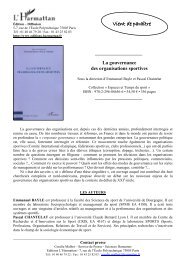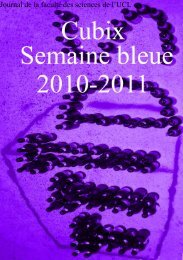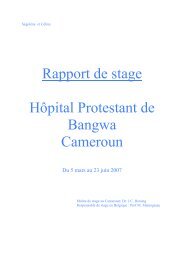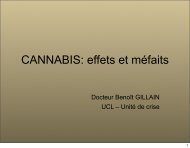Suivi des Tests Thyroïdiens en Médecine Générale
Suivi des Tests Thyroïdiens en Médecine Générale
Suivi des Tests Thyroïdiens en Médecine Générale
Create successful ePaper yourself
Turn your PDF publications into a flip-book with our unique Google optimized e-Paper software.
<strong>Suivi</strong> <strong>des</strong> <strong>Tests</strong> <strong>Thyroïdi<strong>en</strong>s</strong><br />
Thyro di<strong>en</strong>s<br />
<strong>en</strong> <strong>Médecine</strong> M decine <strong>Générale</strong> G rale<br />
Chantal Daumerie<br />
Endocrinologie<br />
UCL, Clin.Univ. ST Luc
Hypothalamus TRH<br />
–<br />
T4<br />
T4<br />
Hypothalamic-Pituitary-Thyroid Physiology<br />
Pituitary<br />
–<br />
TSH Blood Levels T3<br />
Thyroid Gland<br />
T4<br />
–<br />
T3<br />
–<br />
20%<br />
T4 T3<br />
Peripheral Tissues<br />
80%<br />
T3<br />
TR<br />
Target Tissues<br />
Heart<br />
Liver<br />
Bone<br />
CNS
TSH<br />
mIU/L<br />
12<br />
11<br />
10<br />
9<br />
8<br />
7<br />
6<br />
5<br />
4<br />
3<br />
2<br />
1<br />
0<br />
TSH Refer<strong>en</strong>ce Limits Over Three Deca<strong>des</strong><br />
Immunometric assay (IMA)<br />
~10.0<br />
?<br />
~ 5.0<br />
0.3-0.4<br />
1970-85 1985-90 1990-00 2000-<br />
RIA<br />
More s<strong>en</strong>sitive thyroid<br />
Antibody tests<br />
2° IMA<br />
New Guidelines<br />
~ 4.0<br />
0.3-0.4<br />
3° IMA<br />
~ 2.5<br />
0.3-0.4
1000<br />
SH<br />
IU/L<br />
100<br />
10<br />
1.0<br />
0.1<br />
0.01<br />
undetectable<br />
TSH is the Most S<strong>en</strong>sitive Test for Thyroid Status<br />
100<br />
fold<br />
2<br />
fold<br />
Hypothyroid Refer<strong>en</strong>ce NORMAL Range<br />
Hyperthyroid<br />
From: Sp<strong>en</strong>cer et al JCEM 70:453, 1990
13<br />
160<br />
12<br />
14011<br />
10<br />
120<br />
9<br />
1008<br />
7<br />
Free T4<br />
80<br />
Estimate 6<br />
5<br />
60<br />
4<br />
403<br />
2<br />
20<br />
1<br />
00<br />
Individual FT4 Setpoints -Monthly Blood Draws x 1-Year<br />
8 6 11 15 2 4 5 14 1 9 16 13 7 3 12 10<br />
Participants<br />
Population<br />
Refer<strong>en</strong>ce<br />
Range
SH<br />
IU/L<br />
TSH Variability in Euthyroid Volunteers (monthly tests x 1 y<br />
an individual a TSH change that exceeds 0.75 mIU/L is clinically significant.<br />
NACB Guideline #8. Thyroid 13:18,2003<br />
2.5<br />
1.3<br />
0.2<br />
4<br />
3<br />
2<br />
1<br />
12 10 6 4 13 9 14 15 16 5 2 3 8 1 11<br />
%<br />
97.5<br />
mean<br />
2.5
SH<br />
IU/L<br />
ean<br />
.3<br />
4<br />
3<br />
2<br />
1<br />
TSH Population Refer<strong>en</strong>ce Range<br />
12 10 6 4 13 9 14 15 16 5 2 3 8 1 11<br />
Anders<strong>en</strong> JCEM 87:1068, 2002 (n = 1<br />
Hollowell (NHANES) JCEM 87:489, 2002 (n = 1<br />
Group<br />
Refer<strong>en</strong>ce<br />
Range<br />
4.1<br />
Population<br />
Refer<strong>en</strong>ce<br />
Range<br />
2.5<br />
0.2<br />
0.4<br />
Mean<br />
1.4
NACB Guideline 22<br />
Establishing TSH Refer<strong>en</strong>ce Intervals<br />
TSH refer<strong>en</strong>ce intervals should be established from the 9<br />
confid<strong>en</strong>ce limits of the log-transformed values of at lea<br />
120 rigorously scre<strong>en</strong>ed normal euthyroid volunteers wi<br />
No personal or family history of thyroid dysfun<br />
No visible or palpable goi<br />
No medications (except estrog<br />
No thyroid autoantibodies -TPOAb or T<br />
(measured by s<strong>en</strong>sitive immunoassay)<br />
Thyroid 13:36, 200
Lower TSH Population Refer<strong>en</strong>ce Limit<br />
Clinical studies suggest<br />
that the TSH lower limit<br />
approximates<br />
0.4 mIU/L
TSH Upper<br />
Refer<strong>en</strong>ce Limit<br />
is more controversial
NACB Guideline 27<br />
Recomm<strong>en</strong>ded New TSH Upper Refer<strong>en</strong>ce Limi<br />
The majority (>95%) of healthy euthyroid subjects<br />
have a serum TSH below 2.5 mIU/L.<br />
Ambulatory pati<strong>en</strong>ts with serum TSH above 2.5<br />
mIU/L (wh<strong>en</strong> confirmed by a repeat TSH<br />
measurem<strong>en</strong>t made after several weeks) may be in<br />
the early stages of thyroid failure, especially if<br />
TPOAb is detected.<br />
Thyroid 13:42, 2003 & www nacb
Suspect<br />
Hypothyroid?<br />
Diagnosis Algorithm for<br />
Hypothyroidism<br />
TSH<br />
2.5 µU/mL<br />
Go to Next<br />
Step<br />
Singer PA, et al. JAMA. 1995;273:808-812<br />
Demers LM, Sp<strong>en</strong>cer CA, eds. The National Academy of Clinica<br />
Biochemistry Web site. Available a
Free Hormone Concept<br />
Only unbound (free) hormone has metabolic<br />
activity and physiologic effects<br />
– Free hormone is a tiny perc<strong>en</strong>tage of total hormone in<br />
plasma (about 0.03% T 4; ; 0.3% T 3)<br />
Total hormone conc<strong>en</strong>tration<br />
– Normally is kept proportional to the conc<strong>en</strong>tration of<br />
carrier proteins<br />
– Is kept appropriate to maintain a constant free<br />
hormone level
Changes in TBG Conc<strong>en</strong>tration Determine<br />
Binding and Influ<strong>en</strong>ce T 4 and T 3 Levels<br />
Increased TBG<br />
– Total serum T 4 and T 3 levels increase<br />
– Free T 4 (FT 4), ), and free T 3 (FT 3) ) conc<strong>en</strong>trations<br />
remain unchanged<br />
Decreased TBG<br />
– Total serum T 4 and T 3 levels decrease<br />
– FT 4 and FT 3 levels remain unchanged
Drugs and Conditions That Increase Serum<br />
T4 4 and T 3 Levels by Increasing TBG<br />
Drugs that increase TBG<br />
– Oral contraceptives and<br />
other sources of estrog<strong>en</strong><br />
– Methadone<br />
– Clofibrate<br />
– 5-Fluorouracil<br />
Fluorouracil<br />
– Heroin<br />
– Tamoxif<strong>en</strong><br />
Conditions that increase<br />
TBG<br />
– Pregnancy<br />
– Infectious/chronic active<br />
hepatitis<br />
– HIV infection<br />
– Biliary cirrhosis<br />
– Acute intermitt<strong>en</strong>t<br />
porphyria<br />
– G<strong>en</strong>etic factors
L’hypothyro<br />
hypothyroïdie die subclinique<br />
Définition<br />
Désordre biochimique<br />
TSH élevée<br />
Hormones libres normales
L’hypothyro<br />
hypothyroïdie die subclinique<br />
Définition<br />
Désordre biochimique<br />
TSH élevée<br />
Hormones libres normales
L’hypothyro<br />
hypothyroïdie die subclinique<br />
Taux normal de TSH ?<br />
Taux normal de TSH ?<br />
Variations importantes : circadi<strong>en</strong>ne<br />
saisonnière<br />
saisonni re<br />
2 valeurs anormales à 3 mois d’intervalle<br />
d intervalle<br />
Autres causes de TSH élev levée e : - convalesc<strong>en</strong>ce<br />
- jeune prolongé prolong<br />
- médicam<strong>en</strong>ts<br />
dicam<strong>en</strong>ts<br />
(métoclopramide<br />
toclopramide)
Participants With<br />
Elevated TSH, %<br />
Preval<strong>en</strong>ce of Elevated Serum TSH<br />
by Decade of Age and G<strong>en</strong>der<br />
18<br />
16<br />
14<br />
12<br />
10<br />
8<br />
6<br />
4<br />
2<br />
0<br />
13-<br />
19<br />
NHANES III Study (N=17 353)<br />
20-<br />
29<br />
Males<br />
Females<br />
30-<br />
39<br />
40-<br />
49<br />
50-<br />
59<br />
Age, y<br />
60-<br />
69<br />
70-<br />
79<br />
>80<br />
• At
L’hypothyro<br />
hypothyroïdie die subclinique<br />
Préval<strong>en</strong>ce<br />
femme : 7,5 à 8,5%<br />
homme : 2,8 à 4,8%<br />
> 60 ans : 15% femmes, 8% hommes<br />
diabète diab te 1, maladies autoimmunes, autoimmunes,<br />
2%<br />
femmes <strong>en</strong>ceintes avec anticorps+<br />
Hollowell,,Braverman<br />
Hollowell Braverman,JCEM,2002<br />
,JCEM,2002
L’hypothyro<br />
hypothyroïdie die subclinique<br />
Principales causes <strong>des</strong> hypothyroïdies primaires<br />
Principales causes <strong>des</strong> hypothyroïdies primaires<br />
Hypothyroïïdies Hypothyro dies frééqu<strong>en</strong>tes<br />
fr qu<strong>en</strong>tes<br />
thyroïdites thyro dites auto-immunes auto immunes : myxoedème myxoed me atrophique<br />
maladie de Hashimoto<br />
hypothyroïdies hypothyro dies iatrogènes iatrog nes : traitem<strong>en</strong>t par ATS<br />
thyroïdectomie<br />
thyro dectomie<br />
iode 131<br />
induite par l’iode l iode<br />
après apr hyperthyroïdie hyperthyro die induite p<br />
l’iode iode<br />
transitoires non iatrogènes iatrog nes : au décours cours d’une d une thyroïdite thyro dite<br />
subaiguë subaigu
L’hypothyro<br />
hypothyroïdie die subclinique<br />
Principales causes <strong>des</strong> hypothyroïdies primaires<br />
Principales causes <strong>des</strong> hypothyroïdies primaires<br />
Hypothyroïïdies Hypothyro dies rares rares<br />
Hypothyroïdies Hypothyro dies iatrogènes iatrog nes : lithium<br />
cytokines<br />
Maladies infiltratives de la thyroïde thyro de<br />
Frééqu<strong>en</strong>ce Fr qu<strong>en</strong>ce variable variable selon selon les les pays pays<br />
Car<strong>en</strong>ce <strong>en</strong>démique <strong>en</strong>d mique <strong>en</strong> iode
L’hypothyro<br />
hypothyroïdie die subclinique<br />
2 groupes de pati<strong>en</strong>ts :<br />
2 groupes de pati<strong>en</strong>ts :<br />
Ac antiperoxydase positifs : risque d’hypothyro<br />
d hypothyroïdie die<br />
de 5 à 10% par an<br />
Ac antiperoxydase négatifs gatifs : risque de 2% par an<br />
Origine? Thyroïde Thyro de atrophique<br />
Immunité Immunit cellulaire<br />
Mutation de récepteur r cepteur TSH
L’hypothyro<br />
hypothyroïdie die subclinique<br />
Histoire naturelle<br />
Histoire naturelle<br />
Si Ac + et femme : risque de 4,5% par an<br />
Si femme > 60 ans : 1/3 <strong>en</strong> 4 ans<br />
(8%/an)<br />
Si TSH>20 µU/ml U/ml : 80%<br />
Ros<strong>en</strong>thal, JAMA 1987
L’hypothyro<br />
hypothyroïdie die subclinique<br />
Traitem<strong>en</strong>t<br />
Eviter la progression vers l’hypothyro<br />
l hypothyroïdie die vraie<br />
Profil lipidique<br />
Traiter les symptômes
Variation de la cholestérol cholest rolémie mie <strong>en</strong><br />
Mean Total Cholesterol<br />
Level, mg/dL<br />
fonction <strong>des</strong> taux de TSH<br />
280<br />
270<br />
260<br />
250<br />
240<br />
230<br />
220<br />
210<br />
200<br />
209<br />
216<br />
5.1-<br />
10<br />
226<br />
>10-<br />
15<br />
229<br />
>15-<br />
20<br />
238<br />
TSH, µIU/mL<br />
>20-<br />
40<br />
239<br />
>40-<br />
60<br />
270<br />
>60-<br />
80<br />
267<br />
>80
L’hypothyro<br />
hypothyroïdie die subclinique<br />
Traitem<strong>en</strong>t - Effet sur les lipi<strong>des</strong><br />
Traitem<strong>en</strong>t - Effet sur les lipi<strong>des</strong><br />
Controversééss<br />
Controvers<br />
Cholesterol total et LDL augm<strong>en</strong>tés<br />
augm<strong>en</strong>t<br />
Traitem<strong>en</strong>t par T4 diminue le profil<br />
athérog ath rogène ne, , si cholestérol cholest rol >250 mg/dl<br />
T4 inactive sauf si TSH > 10 µU/ml U/ml<br />
Mortalité Mortalit et morbidité morbidit : contradictoires<br />
- Whicham(1977) Whicham(1977)<br />
pas d’influ<strong>en</strong>ce<br />
d influ<strong>en</strong>ce<br />
- Danese(1996) Danese(1996)<br />
2x athéroscl ath rosclérose rose
Hypothyroidism and Depression<br />
Have Many Common Features<br />
Depression Hypothyroidism<br />
• Sleep decrease<br />
• Suicidal ideation<br />
• Weight loss<br />
• Appetite increase/<br />
decrease<br />
• Constipation<br />
• Appetite decrease<br />
• Decreased conc<strong>en</strong>tration<br />
• Decreased libido<br />
• Delusions<br />
• Depressed mood<br />
• Diminished interest<br />
• Sleep increase<br />
• Weight increase<br />
• Fatigue<br />
• Bradycardia<br />
• Cardiac and lipid<br />
abnormalities<br />
• Cold intolerance<br />
• Delayed reflexes<br />
•Goiter<br />
• Hair and skin<br />
changes
L’hypothyro<br />
hypothyroïdie die subclinique<br />
Traitem<strong>en</strong>t - Effet sur les symptômes<br />
Traitem<strong>en</strong>t - Effet sur les symptômes<br />
Controversé<br />
Controvers<br />
Trois étu<strong>des</strong> tu<strong>des</strong> prospectives randomisées<br />
randomis es<br />
- Deux montr<strong>en</strong>t amélioration am lioration 28%<br />
- Réponse ponse meilleure si TSH > 10 µU/mL U/mL
L’hypothyro<br />
hypothyroïdie die subclinique<br />
Traitem<strong>en</strong>t - Effet sur les symptômes<br />
Traitem<strong>en</strong>t - Effet sur les symptômes<br />
La T4 améliore am liore la fonction cardiaque<br />
La T4 diminue la pression intraoculaire<br />
Effet sur les nerfs périph p riphériques riques<br />
Fertilité Fertilit<br />
Pas d’effet d effet sur le poids
L’hypothyro<br />
hypothyroïdie die subclinique<br />
Argum<strong>en</strong>ts contre un traitem<strong>en</strong>t<br />
Argum<strong>en</strong>ts contre un traitem<strong>en</strong>t<br />
Abs<strong>en</strong>ce d’am d amélioration lioration <strong>des</strong> symptômes<br />
Durée Dur e indétermin<br />
ind terminée<br />
Risque de surdosage (21%)<br />
Utiger,1998<br />
Utiger,1998
Subclinical Thyroid Disease Cons<strong>en</strong>sus Panel<br />
“There is no single level of serum TSH at<br />
which clinical action is always either indicated<br />
or contraindicated. The higher the TSH the<br />
more compelling is the rationale for<br />
treatm<strong>en</strong>t”.<br />
“It is important to consider the individual<br />
clinical context (e.g. pregnancy, lipid profile,<br />
TPO antibodies)”.<br />
Surks et al JAMA 291:228, 2004
Threshold for L-T4 Rx. Should be Pati<strong>en</strong>t-<br />
Specific!<br />
Degree of TSH Abnormal<br />
isk Factors for<br />
CVD<br />
Increased lipids<br />
CV disease<br />
Diabetes<br />
Insulin resistance<br />
(BMI)<br />
Hypert<strong>en</strong>sion<br />
>2.5 >10<br />
Decision<br />
to Treat<br />
with L-T4<br />
(Target TSH<br />
0.5-2.0 mIU/L)<br />
TPOAb<br />
Conc<strong>en</strong>tratio<br />
•Age<br />
Other Factors<br />
• G<strong>en</strong>eral health<br />
• Family history<br />
• Compliance<br />
• Pati<strong>en</strong>t prefer<strong>en</strong>ce
Traitem<strong>en</strong>t de L’hypothyro hypothyroïdie die<br />
LThyroxine (LT4) est le traitem<strong>en</strong>t de choix<br />
– Adultes: Adultes 1,7µg/kg/j 1,7 g/kg/j (125µg/j (125 g/j-70kg) 70kg)<br />
Dose variant <strong>en</strong>tre 50 et 200 µg/j g/j, , variation <strong>en</strong><br />
fonction du BMI<br />
– Enfants: Enfants:<br />
jusque 4.0 µg/kg/j g/kg/j<br />
– Agées Ag es: :
Conseils pratiques<br />
LThyroxine à pr<strong>en</strong>dre à jeun, ½ h avant le petit<br />
déje jeûner ner<br />
Dissocier d’au d au moins 4H de la prise de Gélules G lules<br />
de Ca, Fer, vit, soja,fibres, pansem<strong>en</strong>t gastrique<br />
Surveillance: TSH TSH (le mom<strong>en</strong>t de la prise de<br />
sang pas capital)<br />
T4 T4 libre libre (avant la prise de LT4<br />
ou l’apm) l apm)
Thyrotoxicose<br />
Syndrome qui résulte r sulte d’un d un excès exc s d’ d hormones<br />
thyroidi<strong>en</strong>nes circulantes.<br />
circulantes<br />
Causes:<br />
Maladie de Basedow ou de Graves<br />
Goitre multinodulaire toxique<br />
Adénome Ad nome toxique<br />
Factice<br />
Iod-basedow<br />
Iod basedow<br />
Autres
Laboratoire<br />
TSH basse<br />
Elévation El vation <strong>des</strong> T4 et T3 totales et libres<br />
Autoanticorps thyroidi<strong>en</strong>s:<br />
TPO Ab (peroxidase)<br />
(TgAb (thyroglobuline))<br />
TRAB (anti- (anti récepteur cepteur TSH)
Anticorps anti –récepteur cepteur TSH<br />
Ag<strong>en</strong>t causal de la maladie de Basedow<br />
Indications:<br />
Diagnostic de la maladie de Basedow<br />
Index pronostic après apr s traitem<strong>en</strong>t aux ATS<br />
Stimulants: 90% Basedow<br />
Bloquants: 10% Thyroïdite Thyro dite d’Hashimoto<br />
d Hashimoto
Scintigraphie Thyroïdi<strong>en</strong>ne<br />
Thyro di<strong>en</strong>ne<br />
Utile d’avoir d avoir scintigraphie avec test de<br />
captation<br />
1) Mesure de l’avidit l avidité de la glande:<br />
Eliminer contamination iodée iod<br />
Utile si traitem<strong>en</strong>t au radioiode<br />
2) Anatomie de la glande
Pharmacocinétique<br />
Pharmacocin tique<br />
Strumazol Thiamazol co 10mg<br />
Propylthiouracile co 50 mg<br />
Néo-mercazol mercazol Carbimazol co 5 mg<br />
rapidem<strong>en</strong>t absorbés absorb s par TD<br />
accumulés accumul s dans thyroïde thyro de
Avantages et Inconvéni<strong>en</strong>ts Inconv ni<strong>en</strong>ts <strong>des</strong><br />
Avantages:<br />
préservation pr servation de la glande<br />
taux de réponse r ponse<br />
coût co<br />
Désavantages:<br />
savantages:<br />
récidives cidives ( 50 à 70%)<br />
compliance<br />
effets secondaires<br />
ATS
Dose d’attaque d attaque<br />
Effet immunosuppresseur accru<br />
Meilleure réponse r ponse au traitem<strong>en</strong>t<br />
Récidives cidives diminuées diminu es<br />
Dose ATS<br />
Difficulté Difficult de prévoir pr voir réponse r ponse thérapeutique<br />
th rapeutique<br />
Amélioration Am lioration <strong>en</strong> 15 jours<br />
Etat métabolique m tabolique normal <strong>en</strong> 6 semaines<br />
Ajouter Hormones Thyroïdi<strong>en</strong>nes<br />
Thyro di<strong>en</strong>nes<br />
Si euthyroïdie euthyro die<br />
Si goitre
Durée Dur e du Traitem<strong>en</strong>t<br />
12 à 18 mois: temps de rémission r mission plus important<br />
Facteurs influ<strong>en</strong>çant influ<strong>en</strong> ant la rémission: r mission:<br />
petit goitre<br />
diminution du goitre p<strong>en</strong>dant le traitem<strong>en</strong>t<br />
TSH normale<br />
Disparition <strong>des</strong> AC anti récepteur r cepteur TSH
Conseils pratiques<br />
Pour le suivi:<br />
ATS seul jusqu’à jusqu’à<br />
normalisation de la T4<br />
libre ou index<br />
Ne pas att<strong>en</strong>dre normalisation de la TSH<br />
(Sidération (Sid ration Hypophysaire)<br />
Dosage (T4 libre et TSH) toutes les 4-6 4 6<br />
semaines jusqu’à jusqu’à<br />
euthyroïdie, euthyro die, puis tous les<br />
3 mois
Take Home Message<br />
1) Chaque individu a son propre taux de T4 libre<br />
et de TSH (écart ( cart de 0,75 µU/ml)) U/ml))<br />
2) 95% individus ont TSH <strong>en</strong>tre 0,3 et 2,5 µU/ml U/ml<br />
3) En cas d’hypo d hypo subclin.,faire au moins 2 dosages<br />
de TSH à 3 mois d’intervalle d intervalle avant de traiter et<br />
anamnèse anamn se apport iodé iod<br />
4) Si traitem<strong>en</strong>t: adapter pour chaque individu et<br />
viser taux <strong>en</strong>tre 0,5 et 2 µU/ml U/ml<br />
5) Pour l’hyper: l hyper: diagnostic exact<br />
6) Adaptation sur les taux d’hormones d hormones libres







